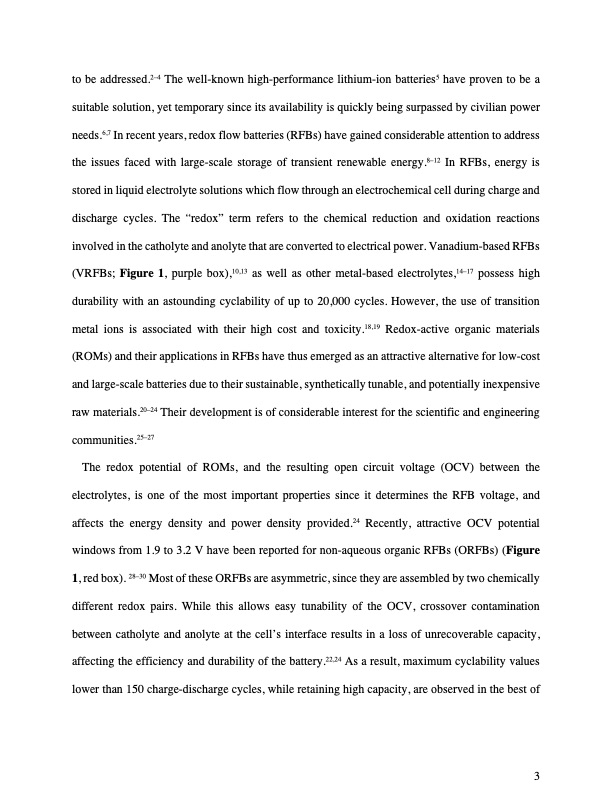
PDF Publication Title:
Text from PDF Page: 003
to be addressed.2–4 The well-known high-performance lithium-ion batteries5 have proven to be a suitable solution, yet temporary since its availability is quickly being surpassed by civilian power needs.6,7 In recent years, redox flow batteries (RFBs) have gained considerable attention to address the issues faced with large-scale storage of transient renewable energy.8–12 In RFBs, energy is stored in liquid electrolyte solutions which flow through an electrochemical cell during charge and discharge cycles. The “redox” term refers to the chemical reduction and oxidation reactions involved in the catholyte and anolyte that are converted to electrical power. Vanadium-based RFBs (VRFBs; Figure 1, purple box),10,13 as well as other metal-based electrolytes,14–17 possess high durability with an astounding cyclability of up to 20,000 cycles. However, the use of transition metal ions is associated with their high cost and toxicity.18,19 Redox-active organic materials (ROMs) and their applications in RFBs have thus emerged as an attractive alternative for low-cost and large-scale batteries due to their sustainable, synthetically tunable, and potentially inexpensive raw materials.20–24 Their development is of considerable interest for the scientific and engineering communities.25–27 The redox potential of ROMs, and the resulting open circuit voltage (OCV) between the electrolytes, is one of the most important properties since it determines the RFB voltage, and affects the energy density and power density provided.24 Recently, attractive OCV potential windows from 1.9 to 3.2 V have been reported for non-aqueous organic RFBs (ORFBs) (Figure 1, red box). 28–30 Most of these ORFBs are asymmetric, since they are assembled by two chemically different redox pairs. While this allows easy tunability of the OCV, crossover contamination between catholyte and anolyte at the cell’s interface results in a loss of unrecoverable capacity, affecting the efficiency and durability of the battery.22,24 As a result, maximum cyclability values lower than 150 charge-discharge cycles, while retaining high capacity, are observed in the best of 3PDF Image | Organic Redox Flow Battery Helical Carbeniun Ion

PDF Search Title:
Organic Redox Flow Battery Helical Carbeniun IonOriginal File Name Searched:
high-voltage-organic-redox-flow-battery-helical-carbenium-ion-electrolyte.pdfDIY PDF Search: Google It | Yahoo | Bing
Salgenx Redox Flow Battery Technology: Salt water flow battery technology with low cost and great energy density that can be used for power storage and thermal storage. Let us de-risk your production using our license. Our aqueous flow battery is less cost than Tesla Megapack and available faster. Redox flow battery. No membrane needed like with Vanadium, or Bromine. Salgenx flow battery
| CONTACT TEL: 608-238-6001 Email: greg@salgenx.com | RSS | AMP |